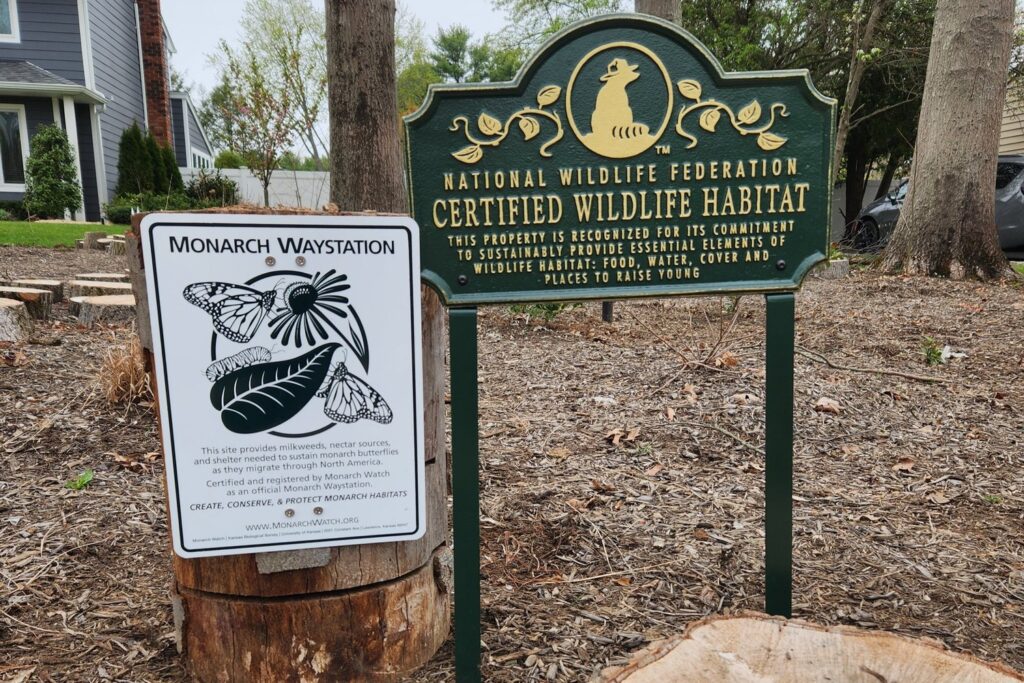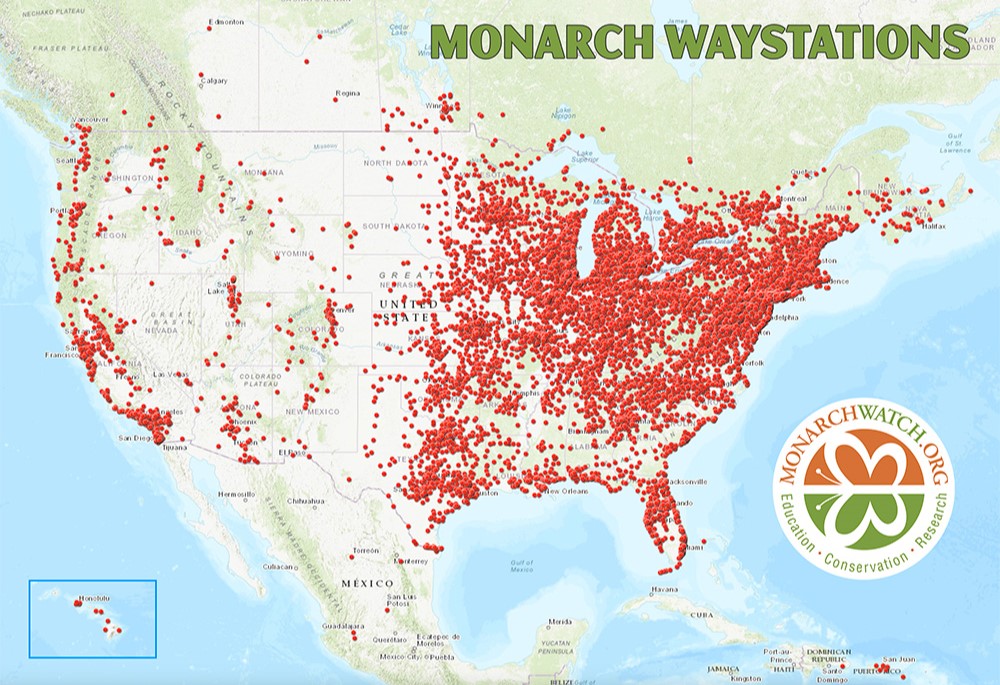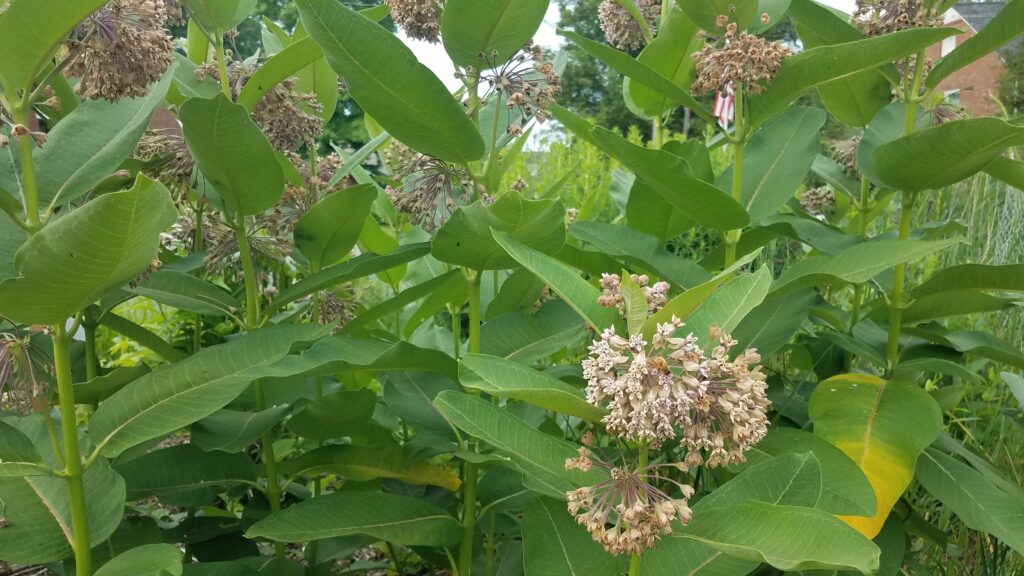When I started my gardening efforts in earnest in the summer of 2018, my intention was to get some bee-friendly plants in the ground so I could guarantee a safe, pesticide-free place for my neighbor’s (and, eventually, my) bees to forage. The more I learned about my flora options, the more I considered the other types of fauna that would benefit from my choices, including monarch butterflies. In 2020, I shared my first post on these beautiful but at-risk creatures, explaining what threats they face and how we can help them. [1] Two years later, after I had grown three types of milkweed from seed, the plants were starting to attract their first visitors. [2] Two years after that (present day), the milkweed was thriving enough that I was ready for my next step: making my monarch habitat official.
I have previously written about garden certifications on this blog: last spring, I highlighted instances in which garden certifications have legally kept the objections of picky neighbors and Home Owner Associations at bay. [3] I read that post to my mom the next time I was home to visit, and she relished feigning complete ignorance of any such programs, only to present me with a surprise garden certification of my own the very next day as a birthday present. That National Wildlife Federation sign is still displayed proudly in my yard. [4]

Image credit: [5]
Now, you certainly don’t have to go through the steps to formally certify a garden in order to have a garden that supports pollinators. I, myself, used Audubon Society criteria to guide what additional steps I needed to take in order to support our local birds, full-well knowing that I would never actually qualify for the actual certification (because I feed our neighborhood’s feral kitties). [6] In several of the garden certification programs I’ve explored to date, the criteria are typically not what I would consider to be particularly stringent, and answering the application questions is based entirely on the honor system.
Making it Official
It’s clear that formal certifications are not necessary for the benefit of the wildlife in any direct way. However, these certification programs provide guidance to gardeners, from what to plant, to how to maintain the habitat, to what they need to know about the creatures visiting the garden. Formal certifications mean revenue that supports informational websites and online communities – and members of those communities are then better able to educate others at the grassroots level, either through formal teaching opportunities (such as with local garden clubs), informal conversations with neighbors (of which I’ve had plenty), or with official yard signage.
Conversations about any garden-scale conservation efforts are important, but education about monarch butterflies is especially critical because of their precarious position. Despite a brief stint on the endangered species list beginning in 2021, migratory monarch butterflies were downgraded to “vulnerable” in 2023 after the evaluation process shifted (not because of an improvement in their population data). [7] Their numbers are still in decline, as of 2023-24 overwintering data from Mexico, [8] with risks to their survival along their migration path, notably from habitat loss as a result of pesticide use, climate change, and security concerns along the Rio Grande. [9] For those reasons, one of the most valuable actions individuals can take is to create safe spaces where monarch butterflies can feed and breed along their migration path.

Image credit: [10]
Despite the fact that no one would be coming out to my house to check and see that everything was as I had described it (or perhaps because that was the case), I didn’t want to move forward with my Monarch Waystation registration until my milkweed plants were reasonably established in the places I intended to keep them. (As I’ve explained to my husband on multiple occasions, the “capital ‘G’ garden” will never be done: it’s a journey, not a destination.) But we’re now at the point when I can comfortably say that my milkweed is never going away, no matter what I do. I even successfully transplanted several common milkweed plants, which is notoriously difficult to do, and this spring they came up in the new and old locations.
Meeting the Bar
In order to get my “Monarch Waystation” certification from MonarchWatch.org, I had to confirm a few things about my garden. There is no minimum size requirement for a waystation, but they do indicate that the most successful gardens will be at least 100 square feet in size. You also need sufficient sun for your garden to support the types of plants that butterflies utilize throughout their lifecycle, most notably milkweed. You need at least one native milkweed plant (more are better, of course), as well as other native plants that provide nectar throughout the season. Finally, you need to employ sustainable garden management practices, such as mulching or avoiding pesticides. [11]
One other thing noted in the application is plant density. A good pollinator garden will have plants placed close enough together to provide shelter for the various visiting species, but neither should the plants be crowded, lest they compete for nutrients in the soil. And common milkweed (as the name might suggest) spreads very easily and requires thinning, particularly if it’s part of a garden of limited size and not just popping up along the side of a field. It is important to be careful when removing milkweed that you’re not also removing monarch eggs or caterpillars. Pulling new shoots in early April and clipping seed pods before they pop open in the fall are your best bets to keep milkweed from spreading too much while also avoiding an accidental removal of the next generation of monarchs. [12]

I will say from personal experience that of the three types I have in my garden, butterfly weed (Asclepias tuberosa) is by far the most polite and easiest to maintain, followed by swamp milkweed (Asclepias incarnata), which involves a lot of dead-heading before seeds start going everywhere. Common milkweed (Asclepias syriaca) spreads very easily by the roots, but the seed pods are large and easy to manage. I only had one syriaca produce flowers and go to seed last year, but this year, shoots came up in multiple locations, and everything is currently covered in flowers… and bees.
Given that vote of confidence from our apian population, I figured it was time to get myself a Monarch Waystation certification in advance of writing this blog post. And while the butterflies themselves won’t care about the new sign in my yard, I am hoping that it sparks conversations with my neighbors… and maybe buys me some goodwill if and when they see the progeny of my milkweed popping up in their yards. If you’re interested in learning more or registering your garden, I encourage you to check out the many resources available here. [13]
Thanks for reading and happy gardening!
[1] https://radicalmoderate.online/monarch-101/
[2] https://radicalmoderate.online/milkweed-monarchs/
[3] https://radicalmoderate.online/for-the-birds/
[4] https://radicalmoderate.online/pollinator-garden-update-2023/
[5] https://www.rewildlongisland.org/blog/i-saw-the-sign-and-it-opened-my-mind-by-duong-vu
[6] http://aswp.org/pages/backyard-habitat-program
[9] https://www.texasobserver.org/texas-butterfly-center-makes-a-comeback-after-right-wing-attacks/
[10] https://monarchwatch.org/waystations/index.html#registry
[11] https://monarchwatch.org/waystations/
[13] https://monarchwatch.org/waystations/
0 Comments